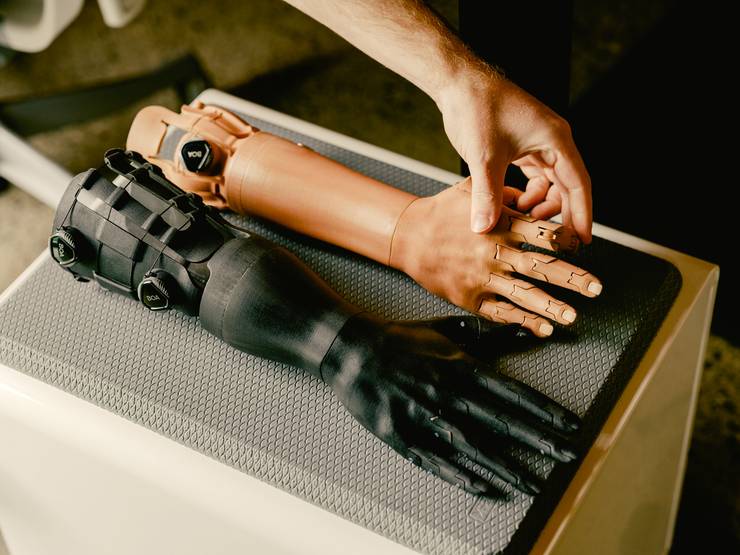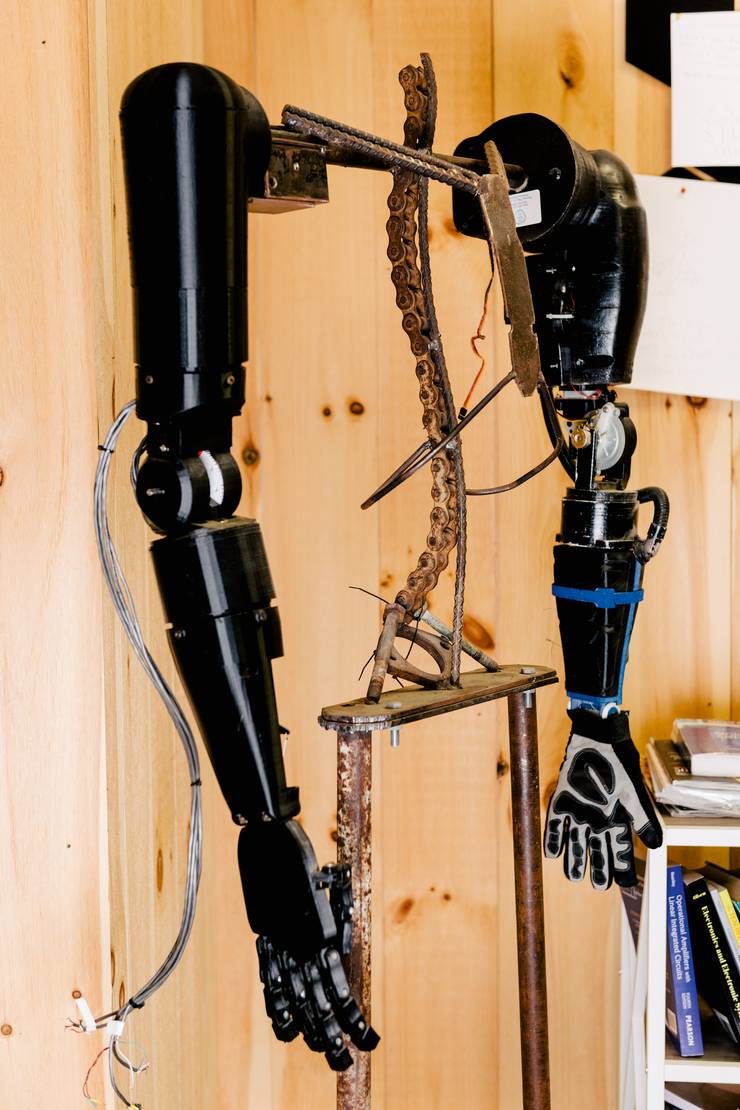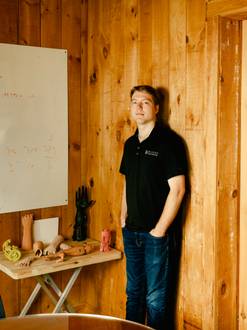Siemens Monocle
Transforming the everyday.
Unlimited Tomorrow creates prosthetics quickly and cost-effectively that allow those with limb loss and limb difference to live a relatively normal life. Here’s how it does it.

Unlimited Tomorrow’s prosthetic limbs are made to suit various skin tones
We take many tasks for granted. Sweeping, cooking, brushing our teeth – tasks that require the full use of our limbs. But for millions globally, such tasks present a daily challenge. There are 57 million people in the world today with limb loss and limb difference. And though prosthetics have a history going back at least as far as Ancient Egypt, only 5 per cent of individuals who require it currently have access to the care and technologies that allow them to live a relatively normal life.
Far from the wooden appendages of the past, modern prosthetics, which are meant to return a certain level of functionality to their users, can be expensive. But there’s a company with a mission to change that – one that’s using data, digital twins and additive manufacturing to fundamentally revolutionise the prosthetics industry.
In 2013, Easton LaChappelle hadn’t yet founded Unlimited Tomorrow, a company based in New York State. He was 17 and tinkered with 3D printers around the house to explore his passion for robotics. Having received some notoriety for a transformer-like arm capable of throwing a baseball and shaking hands, he met a seven-year-old girl at the Colorado State Fair who wore a prosthesis – the first he had seen.
He spoke with the girl and her parents and learned that it can be cost-prohibitive. It only had an open-and-close function, had taken months to create and the girl would soon outgrow it. How could this be, he asked himself, when he was able to create his robotic arm for just $300 (€285)? It was a lightbulb moment. What started as a futuristic passion soon became a life’s calling: to not only make prosthetics more user-friendly but to provide access to the millions of people who can’t afford what was available on the market.
“I quickly realised that I didn’t want to make technology to help one person,” says LaChappelle.
“There was so much need beyond this one little girl at a science fair. This is a global problem and from day one I looked at how I could create accessible and affordable prosthetic technology that could make an impact around the world. That was the vision early on, and is still the vision today.”

Prosthetic limbs in production
The next year he received start-up capital from motivational speaker Tony Robbins, who had attended a TEDx talk LaChappelle had given in Denver, Colorado. Unlimited Tomorrow was born. His team knew that making prosthetics affordable at scale and at the necessary speed would not be easy. Added to that was the challenge of reducing their weight. A typical child’s arm prosthetic is too heavy for some children, many of whom refuse to wear them as a result. Beyond utility, there is a psychological aspect to prosthetics. Children want to fit in – and LaChappelle realised that prosthetics should match a child’s opposing limb as closely as possible.
“There are no set sizes,” says LaChappelle. “Every prosthetic is unique. We make a mirror image of the opposing limb, which is unheard of in the industry. We’re making an extension of someone, both the prosthetic and opposing limb should match perfectly. We offer 140 skin tones and we are now even developing non-skin tones with cool designs, such as silvers and golds.”

Easton LaChappelle, founder of Unlimited Tomorrow
Fast-forward to 2020, when Unlimited Tomorrow introduced TrueLimb. Relying on additive-manufacturing technology, it’s the industry’s first lightweight, affordable, multi-articulating prosthetic limb with a realistic appearance. Weighing in at ½kg, TrueLimbs are lighter than a typical pediatric prosthetic arm and are personalised for each user, down to size, skin tone and fingernails. And starting at $8,000 (€7,600), they’re much less expensive than conventional alternatives. Best of all, they arrive in weeks, not months.
But perhaps the biggest challenge was the socket that attaches to a user’s residual limb – the most important piece of a prosthetic. Not only does it contain the sensors to activate grips but it is also critical to prosthetic comfort. Unlimited Tomorrow engineers were having trouble designing their sockets for the personalised fit that their users needed. With their previous workflow, the engineers would get a 3D scan of a user’s residual limb, load it into their CAD tool and combine it with a generic socket model. But the process was too slow and it was hard to modify the results.
Easton had a chance encounter at a conference with a Siemens AG executive, who claimed he had something that might help. Easton was sceptical: the task was too granular and specific. The suggested NXTM Product Template Studio software gave the team much greater control of the socket geometry and caused a ripple effect throughout the company. Suddenly they were able to make prosthetics much more quickly than before – and they fit their users like a glove.
“I knew how hard a challenge this was.” says LaChappelle. “I didn’t think Siemens could help us achieve our goals in a scalable way. But they proved me wrong and we have been using the software every day to produce probably the highest number of sockets of any company in any given month. Siemens’ expertise has allowed us to develop a really robust solution.”
As a result, they’re able to more accurately simulate digital models of the prosthetics, fine-tuning the variables to ensure not only a proper fit but that the sensors that allow users to move their hands are placed correctly.
“Intellectually, I understood what to expect when I received my TrueLimb in the post, but that was it,” says Abby, a congenital amputee who is one of LaChappelle’s customers. “The sensation and emotion in the feeling of a physical set of fingers moving somewhat independently of each other for the first time was something I couldn’t have imagined or prepared for. I was shocked, excited, flabbergasted, really.”
Unlimited Tomorrow’s TrueLimbs are remarkable and show that, when coupled with a strong vision, digital technologies can make a real difference. By using them in the right way, we can transform entire industries and open up a world of opportunity for millions.
Keep an eye out for the fifth part of our six-part series in Monocle’s September 2022 issue

